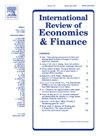揭示货币意外的影响:美国银行的风险承担和信贷供应
IF 4.8
2区 经济学
Q1 BUSINESS, FINANCE
引用次数: 0
摘要
我们为货币政策的意外变化——货币意外——如何影响美国银行的冒险行为和信贷供应提供了新的证据。与以往关注利率变化本身的研究不同,我们强调,偏离预期的政策路径才是推动银行行为的关键因素。使用一种新颖的高频货币意外指标和259家美国银行(2001-2018)的动态面板,我们发现鸽派意外(低于预期的利率)通过降低风险来促进银行的稳健性,而鹰派意外增加银行的风险承担并抑制信贷增长,尤其是家庭贷款。经济上,货币意外通过盈利渠道和资产负债表效应影响银行:意外的货币紧缩减少了资本,放大了冒险的动机。我们的研究结果表明,货币政策的意外——即使在央行高度透明的制度下——仍然是银行行为和金融稳定风险的有力驱动因素。这项工作扩展了货币风险承担的文献,表明不仅利率水平,而且货币行动的意外性对银行有着至关重要的影响,因此提倡将货币政策和审慎政策更紧密地结合起来。本文章由计算机程序翻译,如有差异,请以英文原文为准。
Unveiling the effects of monetary surprises: Risk-taking and credit supply of U.S. banks
We provide new evidence on how unexpected shifts in monetary policy — monetary surprises — influence U.S. banks' risk-taking behavior and credit supply. Unlike prior studies focusing on interest rate changes per se, we highlight that it is the deviation from expected policy paths that crucially drives banking behavior. Using a novel high-frequency measure of monetary surprise and a dynamic panel of 259 U.S. banks (2001–2018), we find that dovish surprises (lower-than-expected interest rates) foster bank soundness by reducing risk, while hawkish surprises increase banks’ risk-taking and dampen credit growth, especially household lending. Economically, monetary surprises affect banks through both profitability channels and balance sheet effects: unanticipated monetary tightening reduces capitalization and amplifies incentives to take risk. Our findings suggest that monetary policy surprises — even under regimes of high central bank transparency — remain potent drivers of bank behavior and financial stability risks. This work extends the monetary risk-taking literature by showing that not only the level of interest rates but the unexpectedness of monetary actions crucially affects banks, thereby advocating for closer integration of monetary and prudential policies.
求助全文
通过发布文献求助,成功后即可免费获取论文全文。
去求助
来源期刊
CiteScore
7.30
自引率
2.20%
发文量
253
期刊介绍:
The International Review of Economics & Finance (IREF) is a scholarly journal devoted to the publication of high quality theoretical and empirical articles in all areas of international economics, macroeconomics and financial economics. Contributions that facilitate the communications between the real and the financial sectors of the economy are of particular interest.

 求助内容:
求助内容: 应助结果提醒方式:
应助结果提醒方式:


